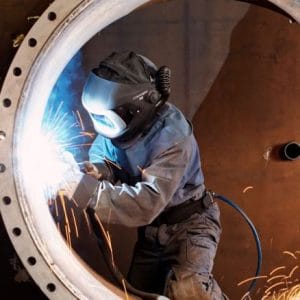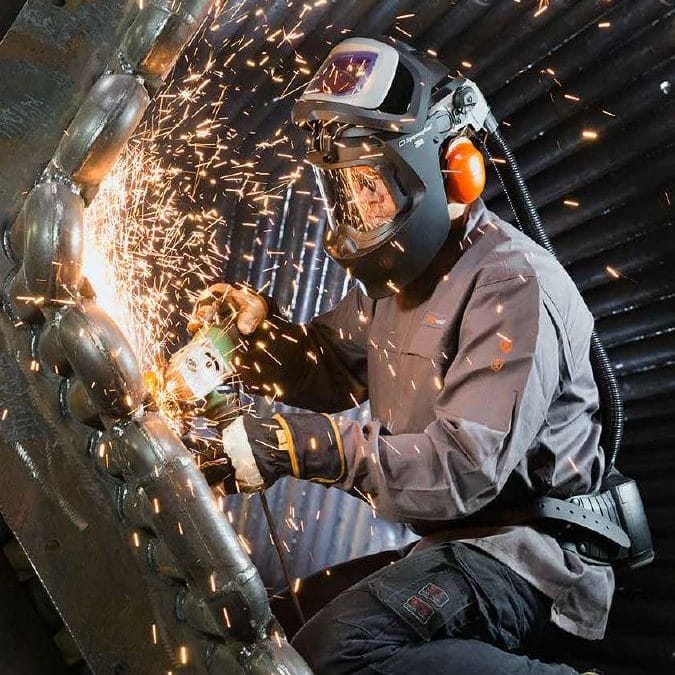For decades welders have known and understood the danger that welding poses to their eyesight. To protect against this danger, welding helmets were developed to protect the eyes, face and neck from flash burn, ultraviolet light, sparks and infrared light and heat.
While standard welding helmets successfully protect welder’s eyes from hazardous light, they do not protect against the harmful fumes released into the air during the welding process.
The safety of welding fumes has been the subject of intense debate for decades. In 1989 welding fumes were determined to be “potentially carcinogenic to humans” and classified by the International Agency for the Research on Cancer (IARC) as a Group 2b carcinogen.
However, in March 2017, IARC reclassified welding fumes as a Group 1 carcinogen, after scientists found significant evidence that welding fumes cause lung cancer and contribute to kidney cancer.
Medical experts have determined that former welders are 44% more likely to contract lung cancer than those who have never worked in the field. And, in 2014, Anh Tran was the first person to be awarded compensation in Australia based on the causal link between working as a welder and lung cancer.
Current Australian workplace standards outline an exposure criteria for specific contaminants. Additionally, there is an industry wide general rule that fume concentration in a welders breathing zone must not exceed 5 milligrams of substance per cubic metre of air.
These safety standards have not been revised since welding fumes were found to cause cancer and do not require welders to wear respiratory protection. Therefore, a worker could be inhaling up to 11 grams of welding fumes – a known carcinogenic material – per year.

The Cancer Council released a number of controls that should be implemented to protect welders on the job. These recommendations related largely to the use of effective personal protective equipment. They outline that welders should “wear either air supplied or air purifying respiratory protection… [and use] a full face welding helmet, with UV filtered lenses.”
To help minimise the dangers associated with welding fumes, Speedglas have developed a range of auto-darkening welding helmets with integrated powered or supplied air respiratory protection.
These helmets can give welders combined eye, face and respiratory protection, whilst keeping them cooler and more comfortable. The innovative design provides five levels of protection, with integrated hearing and safety helmet options.
When worn correctly, powered air purifying respirators have a RMPF of 50. This means that the purified air is a minimum of 50 times cleaner than unfiltered air. Supplied air respirators have a RMPF of 100+, delivering air which is at least 100 times cleaner than the air present in the surrounding environment. Comparatively, disposable and reusable respirators have an RMPF of 10, that’s just 1/5th the protection of a powered air respirator and a 1/10th of the protection provided by a supplied air respirator.
Knowing the dangers associated with welding fumes and the long term effects it can have on the lives of welders and their families is powerful information. And thanks to companies such as Speedglass, we now have the ability and technology to protect ourselves and our employees from the serious health risks associated with welding fumes. Don’t wait for the industry standards to catch up to the science, take the safety of yourself and your employees seriously and implement a strategic approach to reducing exposure to these carcinogens today.
Bibliography
AIHA. (2017). IARC: Welding Fumes, UV Radiation from Welding Are Carcinogenic. Retrieved from https://www.aiha.org/publications-and-resources/TheSynergist/Industry%20News/Pages/IARC-Welding-Fumes-UV-Radiation-from-Welding-Are-Carcinogenic.aspx
Cancer Council. (2019). Welding. Retrieved from https://www.cancer.org.au/preventing-cancer/workplace-cancer/welding.html
Safe Work Australia. (2016). Welding Processes Code of Practice. Retrieved from https://www.safeworkaustralia.gov.au/system/files/documents/1705/mcop-welding-processes-v3.pdf
Speedglas. (2019). Welding Fume: A Known Carcinogen. Artarmon, NSW: 3M.
Toscano, N. (2014). Door opens for welders’ cancer compensation. Retrieved from https://www.theage.com.au/national/victoria/door-opens-for-welders-cancer-compensation-20140815-104h2w.html
Victoria State Government. (2017). Eyes – Flash Burns. Retrieved from https://www.betterhealth.vic.gov.au/health/conditionsandtreatments/eyes-flash-burns
Wikipedia. (2019). Welding Helmet. Retrieved from https://en.wikipedia.org/wiki/Welding_helmet

